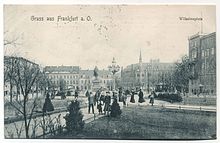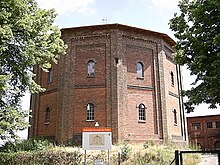Gasworks Frankfurt (Oder)
The Frankfurt (Oder) gasworks started operations in 1856 and closed in 1971. The telescopic gas container was one of the oldest in Germany. The former gasworks marks the beginning of a modern energy supply for the city of Frankfurt (Oder) . With its location stretching as far as the Oder, it still shapes the quarter and its location refers to the course of the medieval city fortifications. The buildings are under monument protection.
location
The gas works is located on the site of the former Lohmühle, adjacent to the old city fortifications to the north. The area is bordered clockwise from the north by the streets Am Graben, Oderpromenade, Lebuser Mauerstraße and Schulstraße.
history
On January 31, 1854, the municipal authorities of the city of Frankfurt decided to build a gasworks and signed a contract with the Frankfurt merchants Ferdinand Schulte and Reinhold Koepp for street lighting with gas lamps and the associated construction of a gas plant. The city reserved the right to acquire the gasworks after 25 years or to take it over after 40 years. The site of the former Lohmühle between the pot market and the Oder was made available as a building site. Here coal could be delivered directly via the Oder. Construction work began in May 1854. A year later, the German Continental Gas Company Dessau, founded in 1855, entered into the contract. On December 20, 1855, the gas works was put into operation. In the years 1856/1857 a gas tank and the retort and machine buildings necessary for gas extraction were built.
The "Frankfurter Patrioten Wochenblatt" published a street lighting table in January 1856. Gas lamps lit Frankfurt's streets for the first time on December 31, 1856. The gas network was constantly expanded. More and more streets and squares were equipped with gas lights. In addition, there were some splendid gas lights in prominent buildings such as the glass-roofed measuring courtyard in Grosse Scharrnstrasse, the government building, the post office and the city theater. The Wilhelmsplatz received two large candelabra with seven sectional burners each. A second gas tank for the gas works followed in 1858. The hospital at the Nikolaikirche, other public buildings, hotels and restaurants were lit with gas from 1859 onwards. From 1871, the telescopic gas container on Schulstrasse, made by the Frankfurt mason F. Gielisch based on designs by W. Voss from Dessau, replaced the second gasometer. From 1878 parks were also lit with gas. On the occasion of the unveiling of the monument to Prince Friedrich Karl in 1888 on the small Wilhelmsplatz, Kaiser Wilhelm II came to Frankfurt. The banquet in the town hall hall was prepared on gas stoves that were set up in the office behind. After this promotional event, private individuals increasingly bought gas stoves. The gas company increased its advertising efforts and advertised the purchase of gas engines, cooking and heating appliances. In 1888, rooms were rented in the house of the cigar manufacturer Clamann in Richtstrasse and a sales and advice center was set up there, which soon became too small: a few years later the advice center moved to Große Scharrnstrasse, which was then Frankfurt's main shopping street. By 1897, the lighting with gas lanterns on Frankfurt's streets was completed. In the same year the successor for gas lighting was announced: The Allgemeine Elektrizitäts-Gesellschaft (AEG) opened an electricity company on a plot of land in Fischerstraße / Bachgasse.
In the spring of 1907, construction of another gasworks began on Küstriner Strasse (today Herbert-Jensch-Strasse) with five ovens and a new bell gas container, which went into operation in 1910. Due to damage at the end of the Second World War , operations had to be stopped on April 22, 1945. Only on December 1, 1945 could operations be resumed with restrictions. In the following years several models of nationalization were considered until the VEB Energieversorgung was founded on August 1, 1954. A few months later, the Frankfurt (Oder) gas operations were spun off and merged with the Eberswalder gas operations to form VEB Gasversorgung Frankfurt (Oder). From 1966, Frankfurt was supplied by rail with liquefied gas from Schwedt, where it was a waste product from the production of heavy heating oil. At the end of the 1960s, Frankfurt was connected to the long-distance gas network via the Schernsdorf junction. The gasometer of the old gasworks has not been used since 1971. In 1979 the last gas lantern in Frankfurt went offline. After the turnaround in 1990, Frankfurt was converted from town gas to natural gas within a year. In the same year, the use of the site of the old gasworks was completely given up.
In 2005 the telescopic gas container was removed and scrapped. Up to this point in time it was the oldest of its kind in Germany.
Building description
The walled-in telescopic gas tank (“gasometer”) is a brick building with a twelve-sided floor plan and stands on an embankment around the tank area that is partially embedded in the ground. The floor of the gasometer is about six meters lower than the surrounding floor. Each wall section is framed by two-step wall templates, with a German band (also called tooth frieze, saw frieze or sawtooth frieze) as a horizontal structure. Small arched windows with iron bars provide a floor division. There is a wrought-iron weather vane on the roof. The telescopic gas container stood inside the building. The striking telescopic gas container was one of the oldest containers of this type in Germany. Although badly damaged by vacancy, much of the original technology is still there. The building was renovated from 2005 to 2007.
The operating buildings are connected to the telescopic gas tank in the east. The retort house with a T-shaped floor plan, built in 1857/1858 and used for gas production , is a two-storey red brick building with a flat gable roof, which is structured by arched windows. The retort house was extended to the west in 1865 by the cleaning building (also: regeneration or cleaning building), the walls of which divide pilaster strips and a German band as a separation between the ground floor and the gable.
Web links
- Entry in the monument database of the State of Brandenburg
- Gas in Frankfurt - how it all began. (PDF; 4.6 MB) In: proFFO, No. 5, 2015 (11). Stadtwerke Frankfurt (Oder), November 7, 2015, p. 2 , archived from the original on April 2, 2016 ; Retrieved April 2, 2016 .
- How the telescopic gas container works. In: gaswerk-augsburg.de. Retrieved April 2, 2016 .
Individual evidence
- ↑ Houses tell stories . Volkshochschule Frankfurt (Oder), 2014, ISBN 978-83-64707-08-7 .
- ↑ Märkische Oderzeitung / Frankfurter Stadtbote, Sept. 7, 2005, p. 13.
- ↑ Official Journal for the City of Frankfurt (Oder), Volume 15, No. 8, Frankfurt (Oder), September 8, 2004
Coordinates: 52 ° 21 '0.2 " N , 14 ° 33' 5.3" E





